Search Results for Tag: Earthquake
Dorje’s Everest sabbatical
Dorje Sherpa is familiar with Everest disasters. In 1996, 20 years ago, he reached the summit of the highest mountain on earth for the first time. Then he belonged to the IMAX film team of the American David Breashears, when a storm in the summit area killed eight climbers within 24 hours. “We were then in Camp 2 at 6,400 meters”, the 50-year-old tells me in his “Buddha Lodge” in the village of Phakding, which lies on the popular trekking route to Everest Base Camp.
![]() read more
read more
Still no light at the end of the tunnel
Chautara appears as if the devastating earthquake had hit it recently, not almost eleven months before. About 15,000 people are living in the city at an altitude of 1,500 meters, the administrative headquarter of Sindhupalchowk District, which was particularly hard-hit by the earthquake on 25 April last year. On the main street many ruined houses still witness to the disaster that killed more than 3,500 people in this mountain region. In many villages about 90 percent of the houses collapsed. The cleanup is progressing slowly. Too heavy are the wounds that the earthquake has ripped, not only at the buildings, but also for the city’s inhabitants. “There is still a very great problem of health,” says doctor Sabina Parajuli. “Those who were injured that time, have not fully recovered because of lots of problems, especially in their limbs. They were operated at that time and not able to do their normal activites. They were the only family members with income, but they are not working and are not getting money. And the other family members are busy with taking care of them.” In addition, infectious diseases such as vomiting or diarrhea spread quickly because the people live in crowded shelters.
![]() read more
read more
“We are ready” in Thulosirubari
“They lost their houses and all their property, but they didn’t lose their plans,” says Arjun Gatraj about the people of his native village Thulosirubari. “There is still hope.” Not only for better times for themselves, but also for their children. “They feel that education is important for their children. They sent them directly after the earthquake as soon as we started the school again.” Arjun is the chairman of the school committee of Thulosirubari, a small mountain village, about 70 kilometers from the Nepalese capital Kathmandu. Almost every family has been affected by the earthquake. “75 people died, among them eight of our students”, Arjun tells me during my visit in Thulosirubari. “About 1800 houses were destroyed, only 30 to 40 are still intact.”
![]() read more
read more
Brice: “Easy to make statements and then do nothing”
He is the doyen of the western expedition operators. The New Zealander Russell Brice has been leading expeditions to the Himalayas since 1974. Hardly any of his colleagues has so much experience as the 63-year-old head of Himalayan Experience, not only in organizing trips to the eight-thousanders but also in dealing with the authorities. It is something that has almost been forgotten, that Russell at an earlier age was an excellent high altitude climber – and an Everest pioneer: Along with the Briton Harry Taylor he first climbed the Three Pinnacles on the Northeast Ridge in 1988.
I wanted to know what Brice thinks about the current situation in Nepal:
Russ, for this spring Himalayan Experience is offering expeditions in Nepal to Mount Everest and Lhotse. How great is the demand?
Very small numbers compared to past years.
Do you notice an impact of the events in 2014 (avalanche in Khumbu Icefall) and 2015 (earthquake and avalanche that hit Everest BC) on your client’s attitude?
![]() read more
read more
Dawa Steven Sherpa: “Chances are running out”
It’s five to twelve, maybe later. Time is running out to tackle man-made climate change. The impacts of global warming can be observed also in the Himalayas, gpt instance in Nepal. “Largely because of climate change and the recent impacts of the earthquake and aftershocks, Nepal has entered an era of accelerated catastrophic events that will impact the country’s population, their lives and livelihoods for several years to come”, US and local scientists said after having researched the greatest and most dangerous glacial lakes in Nepal after the devastating 25 April earthquake.
In these days, delegates from all over the world are debating a new climate change agreement in Paris. On this occasion, I called Dawa Steven Sherpa in Kathmandu. Along with his father Ang Tshering Sherpa, the president of the Nepal Mountaineering Association (NMA), the 31-year-old is managing the expedition operator “Asian Trekking”. Dawa Steven scaled Everest twice (in 2007 and 2008) and in addition the eight-thousanders Cho Oyu (2006) and Lhotse (2009). For years he has been engaging for environmental and climate protection. He is a climate change ambassador for WWF.
![]() read more
read more
Power pilgrimage for Nepal
“We feel very sad to see ‘Ground zero’ of this huge school building”, says Sunil Krishna Shrestha, representative of the German aid organization “Nepalhilfe Beilngries” in Nepal. As reported before, the devastating 25 April earthquake had damaged the “Gerlinde and Ralf School” in the small mountain village of Thulosirubari so badly that it had to be demolished. The ruins had posed a danger to the children who had continued to play there after the quake. Meanwhile, the destroyed school building, where about 700 students from the region around the village had been taught before the quake, was leveled to the ground. “We were able to recover windows, doors and a few school desks and boards from the rubble”, Arjun Gatraj, the chairman of the school management committee at Thulosirubari, writes to me, adding that the old bricks could not be saved because the IOM (International Organization for Migration) had used heavy machinery to demolish the building.
![]() read more
read more
Mingma Sherpa: “It was my worst mistake”
No trace of euphoria. On Wednesday last week, Mingma Gyalje Sherpa reached – as reported in my blog – the 6,685-meter-high summit of Chobutse in Rolwaling Valley in Nepal, solo climbing and for the first time via the West Face – a milestone in the history of Sherpa climbing. But instead of being cheerful the 29-year-old is simply happy that he survived his solo ascent.
Mingma, you have already been on top of Mount Everest, K 2 and five other eight-thousanders. How challenging was your solo ascent on Chobutse?
I have climbed Everest with bottled oxygen and the other six 8,000-meter- peaks without the use of oxygen. When I climbed these high mountains, I did it with partners and on routes with fixed ropes. But a solo ascent means climbing alone in free style, there isn’t any fixed rope or climbing partner to save you if you make a mistake. A mistake means the end of your life. So it is itself challenging. It took me three years to decide to go for a solo climb. Finally, I made it this year. Climbing Chobutse was my worst decision and mistake. I almost lost my life. After my summit success, I spent two nights and days without food, water or tent. I spent two threatening nights and a day at the same place in a whiteout waiting for the weather to clear up. My only satisfaction is that I made it to the summit, though it was the hardest climb of my life.
![]() read more
read more
Habeler: “Go to Nepal – but not all to Everest!”
You would not estimate that Peter Habeler has really 73 years under his belt. Slim, wiry, tanned – just one who is still climbing mountains. Along with friends, he is currently repeating many routes in the Alps that he climbed when he was young, the Austrian told me when I met him at a mountaineers’ event in Leverkusen near my hometown Cologne last weekend: “Thankfully, I feel physically very well. But it’s going round in circles: If you train and climb a lot, you’re just in better physical shape.” Even 37 years after Habeler climbed Mount Everest along with Reinhold Messner for the first time without bottled oxygen, the highest mountain on earth is always in his mind – of course also due to the fact that he as a pioneer is questioned on Everest again and again.
![]() read more
read more
Clearing up after Hindu Kush earthquake
Again, a mountainous region was hit. Yesterday, nearly half a year after the devastating earthquake in Nepal, which had killed closed to 9,000 people, the earth trembled in northern Afghanistan and northern Pakistan. The number of registered deaths has been rising to nearly 400 so far and reportedly several thousand people were injured. As after the quake in Nepal, the rescue teams have not yet reached many remote mountain valleys in Pakistan and Afghanistan. Roads are blocked by landslides. Along the Karakoram Highway, the main connecting axis to the north, 45 landslides were recorded. Meanwhile more than half of the blocked places have been cleared up again. Landslides were also reported from the area around Skardu, the town that many climbers know because it is the starting point of most expeditions to the Karakoram.
![]() read more
read more
Three questions for Ueli Steck
The fall season in the Himalayas is not over yet. Although the expedition on Mount Everest as well as those on the eight-thousanders Makalu, Dhaulagiri and Annapurna were recently canceled due to dangerous conditions on the mountains, there are still a few climbers under way on the highest mountains. So the team of South Korean Sung Taek Hong, who wants to tackle the Lhotse South Face again, decided in favor of a later expedition start. And also Swiss climber Ueli Steck and American Colin Haley have just completed their acclimatization. They did it on separate ways. Steck climbed along with Tenji Sherpa through the North Face of the 6,640-meter-high Cholatse. “That was pretty cool. He is the first Sherpa who climbed this wall”, Ueli writes to me. “It’s nice to see how a ‘new’ generation of Sherpas is growing up, who are really interested in climbing and not just in business. I think that’s awesome!” Steck and Haley want to first repeat the extremely difficult route via the Southeast Pillar to the summit of the 7,804-meter-high Nuptse East which was opened in in 2003 – but contrary to the first climbers, the Russians Valerij Babanov and Yuri Kosholenko, in Alpine style. I sent Ueli three questions to Base Camp.
![]() read more
read more
First the earthquake, now the blockade
At last! Many Western governments have now canceled their general travel warning for Nepal that they had imposed after the 25 April earthquake. Instead, they are now only warning not to travel to certain regions of the Himalayan state. So the German Foreign Office called the trekking regions Langtang and Manaslu problematic areas, where access “is not possible or only with considerable difficulties”. The British Foreign Office advises against traveling to these regions too and calls in addition the districts Sindhupalchowk and Dolakha. From the perspective of the German Government “particular caution is advised” when traveling in these or other areas that were hit hard by the quake. The US Department of State notes that “the frequency and severity of aftershocks have greatly diminished”, but encourages travelers “to consult carefully with their travel and trekking agencies for current, location-specific information and to heed warnings of potential danger”. All those governments point to a new problem in Nepal – a political one.
![]() read more
read more
People like Mahesh
It is far from easy to survive in the highly competitive tourism market in Nepal. Under normal circumstances, but all the more after the earthquake last spring. There are hundreds of trekking and expedition agencies in Kathmandu that compete to get any clients. Most of them are small companies, and the owners often live from hand to mouth. Small entrepreneurs like my friend Mahesh Kumar Budha suffer most from the economic consequences of the earthquake. The government estimates that the tourism market has slumped by 50 percent, local operators assume that it is up to 70 percent.
![]() read more
read more
Dominik Mueller: “I feel absolutely safe”
The 8,136-meter-high Manaslu is probably the only mountain in Nepal, where currently almost everything is as usual in fall. “We have about 15 expeditions here, many of them small teams”, Dominik Mueller tells me by satellite phone from the about 4,800-meter-high Manaslu Base Camp in western Nepal. “All in all we have probably 120 to 130 summit aspirants.” Dominik is leading an expedition of his German operator Amical alpin, along with the mountain guide Rainer Pircher. The other members are ten clients, three Climbing Sherpas, a cook and four kitchen helpers. The Base Camp is not too crowded, says Dominik. “We have found a very nice place for our tents.” On Wednesday, the puja will be held, the traditional Buddhist ceremony to get the gods’ blessings for the climbers. Some expeditions – such as the group of Himalayan Experience that is led by the New Zealander Russell Brice – have been on the mountain for a while already.
![]() read more
read more
Dawa Steven Sherpa: “Ke garne! We carry on!”
There is a jinx on it. Two spring seasons on Everest in a row remained without summit successes (I ignore those of the Wang Jing team in 2014 because they were flown by helicopter to the high camp). In 2014, all commercial expeditions were cancelled after an avalanche had killed 16 Nepalese climbers in Khumbu Icefall. This year, the devastating earthquake in Nepal triggered an avalanche from the seven-thousander Pumori hitting Everest Base Camp and killing 19 mountaineers and support staff. Once again the spring season ended before it had really begun. What does this mean for the Sherpa people?
I called Dawa Steven Sherpa. Along with his father Ang Tshering Sherpa, the president of the Nepal Mountaineering Association (NMA), the 31-year-old is managing “Asian Trekking”, a Kathmandu-based leading operator for expeditions and trekkings in the Himalayas. Dawa Steven scaled Everest twice (in 2007 and 2008) and in addition the eight-thousanders Cho Oyu (2006) and Lhotse (2009). Under his expedition leadership more than 150 climbers have summited Everest. But Dawa Steven is also a tireless fighter for environmental and climate protection in the Himalayas. Furthermore he is leading “Resilient Homes” , a project of the “Himalayan Climate Initiative” to help earthquake-affected communities to rebuild their houses and other buildings – one more reason to talk to him about the current situation in Nepal.
![]() read more
read more
Demolition of school has begun
It was simply too dangerous. In the village of Thulosirubari in the Nepalese earthquake zone, residents and helpers of the International Organization for Migration (IOM) have begun to remove the debris of the school. The building that was heavily damaged by the quake on 25 April “stands dangerously on the side of the ground where children use to play”, Arjun Gatraj, chairman of the School Management Committee, writes to me. As reported, the ground floor of the “Gerlinde and Ralf School” had collapsed, the building cannot be maintained. “These days, we have the big problem on how to destroy the main building and how to clear the rubble”, says Arjun. “We have no money for that ant the Government of Nepal is also not able to support us.”
![]() read more
read more



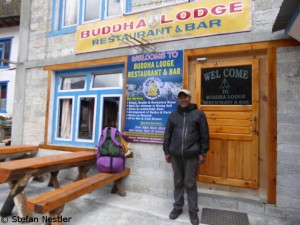

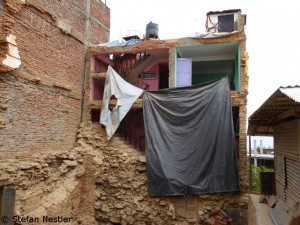
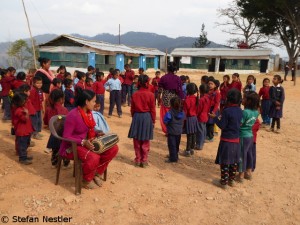
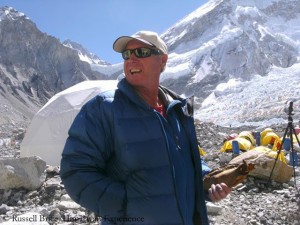
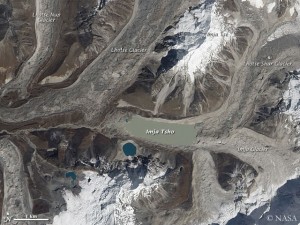
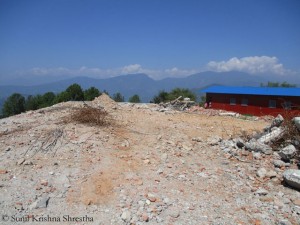
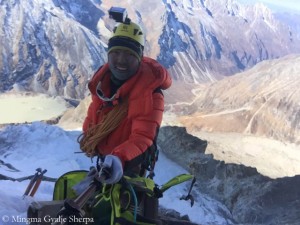
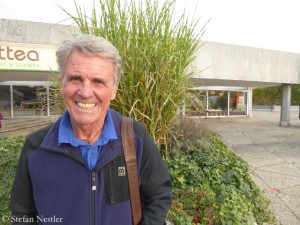
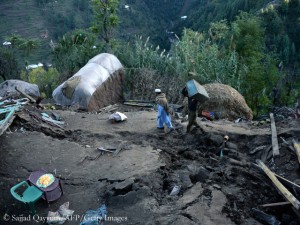
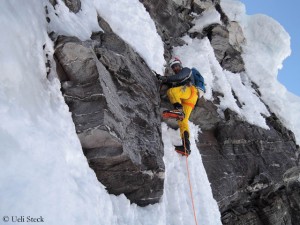
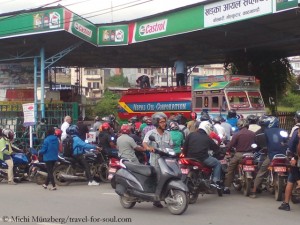
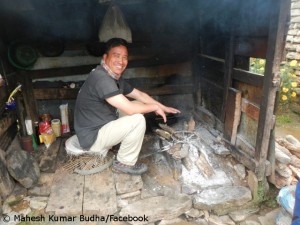
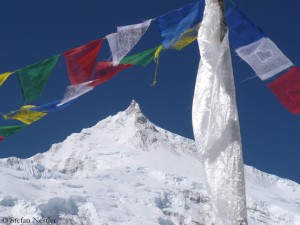

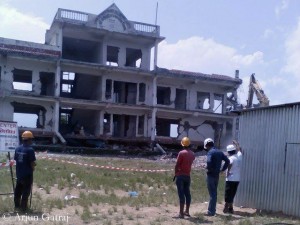





Feedback